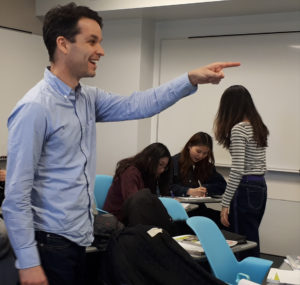Introduction
Few places are as anxiety provoking as the second language (L2) classroom. There, learners at all levels of mastery often experience feelings of inauthenticity and incompetence as they develop new linguistic and intercultural skills. The research community refers to the resulting emotional state as foreign language anxiety, a situation-specific form of anxiety, which implies that it can even affect individuals who may not experience anxiety in other situations.
Given the anxiety inherent to the second language classroom, it is not surprising that researchers focused on the effects of this negative emotional state when they began studying the relationship between affect and second language acquisition in the 1970s. Numerous studies have since shown that this type of anxiety significantly interferes with learning comprehension and production (MacIntyre & Gardner, 1994). A suggested cause for these observed learning deficits is that anxiety hijacks the cognitive resources crucial for learning, such as attention and memory, automatically redirecting them from the learning task toward the source of the anxiety (Eysenck, 1979).
Positive emotions such as joy, interest, contentment, pride and love have a broadening effect on cognition and encourage engagement, creativity and exploration, thus fostering learning and a sense personal well-being.
Most early models used to study emotional states looked at negative emotions, such as anxiety, which restrict cognitive resources and engender avoidance behaviour. However, more recently, research has begun to suggest that exclusively embracing this perspective paints only part of the picture. According to the broaden-and-build theory, positive emotions such as joy, interest, contentment, pride and love have a broadening effect on cognition and encourage engagement, creativity and exploration, thus fostering learning and a sense personal well-being (Fredrickson, 2013).
The complex interplay between negative and positive emotional states in the context of second language learning raises questions regarding how teachers can create optimal learning environments for their students. More specifically, devising ways in which to reduce anxiety may not suffice when teachers strive to improve their learning outcomes. Research findings provide strong evidence that teachers should also foster positive emotional states in their students (Dewaele & MacIntyre, 2014). Cultivating the flow state is one way of achieving this goal.
What is flow?
Characterized by intense concentration and involvement, the flow state is one of the most extensively researched positive emotional states. When experiencing this peak motivational state, individuals lose track of time and self-consciousness while performing challenging but doable tasks (Csikszentmihalyi, 1990).
Mihaly Csikszentmihalyi coined the term flow state in 1975 and carried out pioneering research on the construct. Early flow state research aimed to understand the conditions that allow artists and athletes to flourish by entering into concentrated, trance-like states, losing themselves in their work for hours (Csikszentmihalyi, 1975). Ever since, the concept of a highly focused mental state conducive to productivity has been widely referred to across a variety of fields.
To define the characteristics of this optimal experience of flow, Csikszentmihalyi (1990) and his colleagues collected data from thousands of participants using an ingenious method. Participants wore a pager that, when randomly activated, incited them to stop and record what they were doing and how they were feeling. Participants experiencing these optimal emotional states were not engaged in leisure activities, as one might expect, but rather in stimulating and meaningful tasks for which they perceived themselves as having:
- skills matching the challenges
- clear goals and immediate feedback on progress and outcomes
- total awareness of actions and deep concentration
- a sense of total control
- a loss of self-consciousness
- a sense of time flying
Csikszentmihalyi refers to these as the elements of enjoyment. Interestingly, flow was the word many participants used to describe these intensely enjoyable and productive situations.

Csikszentmihalyi argues that humans expand and flourish while in a flow state, and research suggests that participants experiencing flow exhibit exploratory behaviors, pushing them beyond current skill levels (Trevino & Webster, 1992) and enhancing task performance (Csikszentmihalyi, 1990; Jackson & Roberts, 1992).
Flow and the second language classroom
The elements of enjoyment referred to by Csikszentmihalyi closely resemble conditions that most second language teachers and researchers would consider favorable to learning. It is, therefore, not surprising that a small number of studies (e.g., Egbert, 2003; Kirchhoff, 2011) have already looked at flow in the classroom. For instance, Egbert (2003) observed significant flow in a text chat activity and Kirchhoff (2011) detected elevated flow levels during an extensive reading course.
However, while these studies show that flow does exist in the classroom, they do not tell us much about the specific dimensions or characteristics of tasks, activities and other teacher practices that are favorable to flow. Identifying those characteristics would allow us create a framework to help teachers render current practices more enjoyable by tweaking specific aspects, such as adding a game element to a current activity, or rendering it more kinesthetic and interactive. We believe that identifying specific flow-inducing activity characteristics will help harness positive emotions in the second language classroom and promote engagement, creativity and exploration.
A facilitating methodology
In an ongoing pilot study, we developed a methodology to help address this theory. We are currently working with ten Cégep teachers of French and English as a second language and their students (n=300). Each teacher chooses five activities that students evaluate for flow at various points throughout a semester. In order to evaluate an activity, teachers and students fill out separate online Google Form questionnaires.
The teacher questionnaire has 25 items defining the activity characteristics, which include items such as:
- the targeted competencies (e.g., grammar, vocabulary, pragmatics)
- the competency modes (e.g., listening, speaking, interacting, reading writing)
- the interactive dynamics (whether the activity was performed individually, in pairs or in groups)
- the teacher-student dynamics (whether the activity was teacher or student centered)
- pre-task planning, (whether or not students had time to prepare before completing the activity)
- competition (whether or not the activity was competitive)
- timing (whether or not the activity was timed)
On their end, students anonymously complete a flow questionnaire, developed by Webster, Trevino and Ryan (1993), containing 14 items. The evaluate the items using a Likert scale ranging from 1 (strongly agree) to 6 (strongly disagree). Here is a sample of the items:
- This task excited my curiosity.
- This task was interesting in itself.
- I felt that I had no control over what was happening during this task.
- When doing this task, I was aware of distractions.
- This task bored me.
- I would do this task even if it were not required.
Since we wanted to gather flow data on a wide range of activity types, we encouraged the participating teachers to evaluate their most engaging ones as well as their least engaging ones. Thus, we asked teachers to evaluate student flow after grammar quizzes, games, collaborative writing exercises, oral presentations, online vocabulary exercises, conversation tasks, etc.
The preliminary results from 24 tasks (424 respondents) suggest that games and other interactive activities conducted in a group setting, involving movement, an element of competition and ongoing feedback generate significantly more flow in the L2 classroom. We also observed several trends approaching significance suggesting that students experience more flow in non-evaluative situations and during timed activities. More data will be needed, however, to see if these trending factors do indeed significantly influence flow.
Based on this pilot study, we suggest the following learning activity characteristics for creating flow in the second language classroom:
- Gamifying activities: Because games are some of the highest-rated activities in our study, it is a great idea to create both team and individual leaderboards or to use Socrative, a free web application which easily gamifies classroom quizzes and exercises.
- Getting students into conversations: It turns out that students love to have both free-form and guided conversations with other students. For example, different Information Gap Activities rated highly in flow in our pilot study. One example of an Information Gap Activity is Complete the Text where students receive two versions of a story with different missing information. Students must read and talk together in order to fill in the missing parts of the story.
- Timing activities: When starting an activity, display the Google online stopwatch application on the whiteboard to give your students just enough pressure to move them into flow.
In addition, we suggest that teachers create activities that combine the most engaging activity characteristics from our study to create even more flow for their students. For instance, paired dictation, where two students sit together with one student writing what his/her partner reads out loud, is an engaging activity because it already encourages conversation and negotiation between pairs. In order to make it even more engaging, teachers can add both movement and a game element to the activity. The activity called Read and Run, where pairs of students complete a dictation competition walking around the room, is one of the highest-rated activities for flow in the pilot study.
Ongoing research
We are excited about the opportunity to continue to work on this study in order to bring teachers and students more scientifically backed recommendations for making learning more flow inducing and more engaging. We would like to thank Vanier College for supporting our contribution to the project through the Vanier Development and Support Opportunities Grant (DSO) we received. We are also excited to have received funding from the Social Sciences and Humanities Research Council of Canada (SSHRC).
Michael Zuniga, Ph.D.
Département de didactique des langues
Université du Québec à Montréal,
E-mail: zuniga.michael_j@uqam.ca
Avery Rueb
French Department
Vanier College
E-Mail: rueba@vanier.college
An earlier version of this article was published in the Infolettre du reseau collegial on October 24, 2018. You can see it at this URL: http://lescegeps.com/pedagogie/apprentissage_et_reussite_scolaire/flow_and_anxiety_in_the_second_language_classroom

Avery Rueb
is a teacher in the French department. He co-authored this article with Michael Zuniga, Ph.D., who is a professor in the Département de didactique des langues at Université du Québec à Montréal.
References
Csikszentmihalyi, M. (1975). Beyond boredom and anxiety. San Francisco: Jossey-Bass.
Csikszentmihalyi, M. (1990). Flow: The psychology of optimal experience. New York: Harper & Row.
Dewaele, J.-M., & MacIntyre, P. D. (2014). The two faces of Janus? Anxiety and enjoyment in the foreign language classroom. Studies in Second Language Learning and Teaching, 4, 2, 237-274.
Egbert, J. (2003). A study of flow theory in the foreign language classroom. The Modern Language Journal, 87, 499–518.
Eysenck, M. W. (1979). Anxiety, learning and memory: A reconceptualization. Journal of Research in Personality, 13, 363-385.
Fredrickson, B. L. (2013). Updated thinking on positivity ratios. American Psychologist, 68,9, 814-822.
Jackson, S., & Roberts, G. (1992). Positive performance states of athletes: Toward a conceptual understanding of peak performance. The Sports Psychologist, 6, 156–171.
Kirchhoff, C. (2011). L2 extensive reading and flow: Clarifying the relationship. Reading in a Foreign Language, 25, 2, 192-212.
MacIntyre, P. D. & Gardner, R. C. (1994). The subtle effects of language anxiety o cognitive processing in the second language. Language Learning, 44, 2, 283-305.
Trevino, L., & Webster, J. (1992). Flow in computer-mediated communication: Electronic mail and voice mail evaluation and impacts. Communication Research, 19, 539–573.
Webster, J., Trevino, L., & Ryan, L. (1993). The dimensionality and correlates of flow in human computer interactions. Computers in Human Behavior, 9, 411–426.


